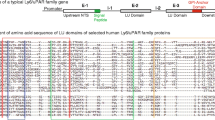Abstract
The cytokine receptor family consists of a growing number of structurally and evolutionarily related transmembrane receptors. CRFB4 and IFNAR are two of the most similar members of this family. They are encoded by two neighboring genes on both human chromosome 21 and murine chromosome 16. The sequence of the human CRFB4 gene was determined from the first exon to the last intron. The nature of the repetitive sequences present in the introns was analyzed and compared with those present in the human IFNAR gene. This analysis leads to considerations of the antiquity of the duplication that gave rise to both genes from a common ancestor. A pseudogene for USF has been identified in the IFNAR gene and a new definition for the repetitive sequence MER37 is proposed. The polymorphism associated with two CA repeats present in the CRFB4 gene is described.
Similar content being viewed by others
References
Batzer MA, Gudi VA, Mena JC, Foltz DW, Herrera RJ, Deininger PL (1991) Amplification dynamics of human-specific (HS) alu family members. Nucleic Acids Res 19:3619–3623
Bazan JF (1990) Structural design and molecular evolution of a cytokine receptor superfamily. Proc Natl Acad Sci USA 87:6934–6938
Economou EP, Bergen AW, Warren AC, Antonarakis SE (1990) The polyadenylate tract of Alu repetitive elements is polymorphic in the human genome. Proc Natl Acad Sci USA 87:2951–2954
Gregor PD, Sawadogo M, Roeder RG (1990) The adenovirus major late transcription factor USF is a member of the helix-loop-helix group of regulatory proteins and binds to DNA as a dimer. Genes Dev 4:1730–1740
Iris FJM, Bougueleret L, Prieur S, Caterina D, Primas G, Perrot V, Jurka J, Rodriguez-Tome P, Claverie JM, Dausset J, Cohen D (1993) Dense Alu clustering and a potential new member of the NfκB family within a 90 kilobase HLA class III segment. Nature Genet 3:137–144
Jurka J, Milosavljevic A (1991) Reconstruction and analysis of human Alu genes. J Mol Evol 32:105–121
Jurka J, Walichiewicz J, Milosavljevic A (1992) Prototypic sequences for human repetitive DNA. J Mol Evol 35:286–291
Jurka J, Kaplan DJ, Duncan CH, Walichiewicz J, Milosavljevic A, Murali G, Solus JF (1993) Identification and characterization of new human medium reiteration frequency repeats. Nucleic Acids Res 21:1273–1279
Korenberg JR, Rykowski MC (1988) Human genome organization: Alu, Lines, and the molecular structure of metaphase chromosome bands. Cell 53:391–400
Kremer E, Baker E, D'Andrea RJ, Slim R, Phillips H, Moretti PAB, Lopez AF, Petit C, Vadas MA, Sutherland GR, Goodal GJ (1993) Acytokine receptor gene cluster in the X-Y pseudoamosomal region? Blood 82:22–28
Lutfalla G, Gardiner K, Proudhon D, Vielh E, Uzé G (1992) The structure of the human interferon alpha/beta receptor gene. J Biol Chem 267:2802–2809
Lutfalla G, Gardiner K, Uzé G (1993) A new member of the cytokine receptor gene family maps on chromosome 21 at less than 35 kb from IFNAR. Genomics 16:366–373
McInnis MG, Lutfalla G, Slaugenhaupt S, Peterson MB, Uzé G, Chakravard A, Antonarakis SE (1991) Linkage mapping of highly informative DNA polymorphisms within the human interferon alpha receptor gene on chromosome 21. Genomics 11:573–576
Milatovich A, Kitamura T, Miyajima A, Francke U (1993) Gene for the α-subunit of the human interleukin-3 receptor (IL3RA) localized to the X-Y pseudoamosomal region. Am J Hum Genet 53:1146–1153
Nelson DL, Ledbetter SA, Corbo L, Victoria MF, Ramirez-Solis R, Webster TD, Ledbetter DH, Caskey CT (1989) Alu polymerase chain reaction: a method for rapid isolation of human-specific sequences from complex DNA sources. Proc Natl Acad Sci USA 86:6686–6690
Pearson PL, Kidd KK, Willard HF (1987) Report of the committee on human gene mapping by recombinant DNA techniques. Cytogenet Cell Genet 46:390–566
Sambrook J, Fritsch EF, Maniatis T (1989) Molecular cloning, a laboratory manual, second edition. Cold Spring Harbor Laboratory Press, Cold Spring Harbor, NY
Shen MR, Batzer MA, Deininger PL (1991) Evolution of the master Alu gene(s). J Mol Evol 33:311–320
Smit AFA (1993) Identification of a new, abundant superfamily of mammalian LTR-transposons. Nucleic Acids Res 21:1863–1872
Stallings RL, Torney DC, Hildebrand CE, Longmire JL, Deaven LL, Jett JH, Doggett NA, Moyzis RK (1990) Physical mapping of human chromosomes by repetitive sequence fingerprinting. Proc Natl Acad Sci USA 87:6218–6222
Tanzi RE, Romano DM, Berger R, Buraczinska MJ, Gaston SM, Kumit DM, Patterson D, Gusella JF, Steward GD (1992) Sequence-tagged sites (STSs) for a set of mapped markers on chromosome 21. Genomics 14:498–502
Thoreau E, Petridou B, Kelly PA, Djiane J, Mornon J-P (1991) Structural symmetry of the extracellular domain of the cytokine/growth hormone/prolactin receptor family and interferon receptors revealed by hydrophobic cluster analysis. FEBS Lett 282:16–31
Uzé G, Lutfalla G, Gresser I (1990) Genetic transfer of a functional human interferon alpha receptor into mouse cells: cloning and expression of its cDNA. Cell 60:225–234
Watkins P, Tanzi RE, Roy J, Stuart J, Stanislovitis P, Gusella JF (1987) A cosmid clone genetic map of chromosome 21 and localisation of the breast cancer estrogen-inducible (BCEI) gene. Cytogenet Cell Genet 46:712
Author information
Authors and Affiliations
Additional information
The nucleotide sequence reported in this paper has been deposited to GenBank with accession numbers U08988 and U12021
Correspondence to: G. Lutfalla
Rights and permissions
About this article
Cite this article
Lutfalla, G., McInnis, M.G., Antonarakis, S.E. et al. Structure of the human CRFB4 gene: Comparison with its IFNAR neighbor. J Mol Evol 41, 338–344 (1995). https://doi.org/10.1007/BF00186545
Received:
Accepted:
Issue Date:
DOI: https://doi.org/10.1007/BF00186545




